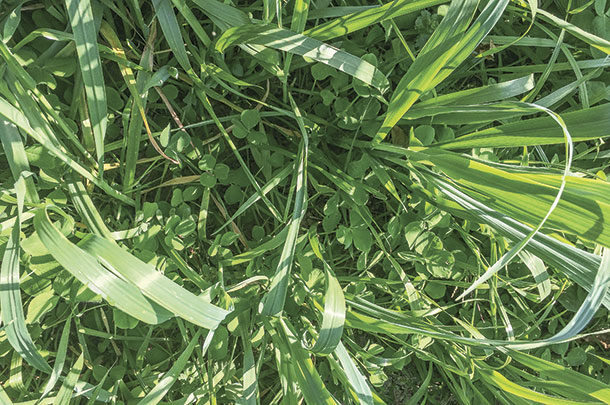A living mulch is any crop that is set aside to keep soil covered, protected and nourished, whether it’s growing alongside a cash crop or alone, and whether it is primarily intended as a cover crop or forage.
Think about what any mulch does in your garden or conservation areas. It protects soil. It locks in moisture even in dry conditions, moderates soil temperature, prevents sunlight from triggering weed seed germination and shelters all kinds of beneficial soil life. Dry, exposed, desiccated soil is not alive the way protected, sheltered, moist soil is.
A living mulch gives all these benefits plus the perks of self-maintenance and soil building. It helps build soil while suppressing weeds to manage the need for tillage. In many situations, this crop has great overlap with a simple cover crop, although “living mulch” is a more descriptive idea.
It contributes to active nutrient cycling, uptaking excess nutrients the main crop can’t use, yet mostly works in the background. It has to be a low-maintenance, unobtrusive player in the cropping scheme.
Living mulches are often distinguished by their use in a relay cropping system – the overlap of part or all of their life cycle with that of the main crop. Relay crops are intentionally used as a companion to the primary crop, and their slower, later growth complements the primary crop with weed suppression and erosion control.
Relay cropping is also useful in timing terms. It gets the next crop established on time or early – that way, there is no gap in growth after the current cropping window ends and no lag time in soil coverage as the new crop gets established. These living mulches and cover crops in general are used because they mostly keep the good stuff in and the bad stuff contained.
They keep the goodies – nutrients, water and mycorrhizae – in place in the soil and contain pests, soil diseases and weeds. They regulate soil temperatures. They also help by giving you a polyculture. Added diversity in the field improves ecosystem services, making the crop more efficient at capturing nutrients, light and other limiting resources.
The main contexts for living mulches include:
1. Conservation – Probably the most common setting for a living mulch is in conservation, where little maintenance will be done and long-term soil stabilization is the primary goal. This could apply in orchards, vineyards, in between vegetable rows or along waterways.
A year-round living crop builds organic matter, which helps with aggregated stability and moisture retention. In this case, you will look for a low-growing perennial, such as a clover (white clovers are often longer lived) or a turf-type grass that will need little mowing. The species doesn’t matter so much as the durability and tolerance to a wide range of conditions.
2. Double crop – Like the classic cover crop, the living mulch (usually an annual in this case) fits in the window after one crop is harvested and before the next is established, and there is little or no overlap unless you plant green. Quick-growing annuals like nitrogen-fixing clovers, cereal grains and brassicas are most common. Or the second crop could be a summer annual like buckwheat, sorghum-sudan or sunflowers – a “break crop” or “catch crop” to shake up the rotation a little and provide extra forage if appropriate.
3. Interseeding, co-seeding, overseeding or otherwise companion planting - In this case, the emphasis will be on a low-growing, shade-tolerant crop that protects soil, cycles nutrients, keeps weeds back and stays in the shadow of the main crop. Dutch white clover, subterranean clover, Italian ryegrass, turf-type or creeping fescues, and ryegrasses are good options here.
Much of the time in this situation, the living mulch will later double as a forage. Many lower-growing, cool-season or perennial forage crops can work in this situation, as long as they are carefully managed. In a vegetable rotation, a living mulch is an excellent companion or border crop in between rows and should be especially low-growing and traffic-tolerant in this scenario.
Depending on its use, a living mulch should be a dwarf of its species, traffic-tolerant and able to survive challenging soil conditions. Shade tolerance is helpful. Living mulches work if they can spread by rhizomes or stolons and grow dense enough to compete with weeds, but not so aggressively that they choke out the main crop.
If the living mulch is going to overlap with the main crop, it usually has to be suppressed or controlled at some point to minimize competition. Sometimes strip tillage is used (cultivation of only the strips in which each row of crop will grow). Sublethal herbicide applications can also knock the mulch back just enough to let the crop establish.
Interseeding in corn is completed at V5-V6 by design, past corn’s critical weed-free period. This is the point at which competition from other species can do less potential damage, and the corn begins to develop the advantage of a canopy to shade out between-row growth.
White clover is one of the most common relay crop mulches – it grows low, has some spreading ability to fill in gaps, occupies the shady understory of a taller crop and maintains all the soil-building properties you look for in a cover crop – building organic matter and soil tilth, keeping soil covered to prevent desiccation and erosion, keeping moisture sealed in and weeds under wraps.
With row crops like corn, exposed soil between the rows is vulnerable to erosive loss from heavy rain events. An intercropped living mulch can intercept much of this loss, keeping runoff from the field much cleaner.
White Dutch clover fixes 75 to 150 pounds of nitrogen per acre per year. Its extensive root system builds up the upper level of soil and makes it more friable (easily crumbled and worked). It tolerates some degree of shade, heat, flooding and drought. It also doesn’t build up harmful nematode populations or other pest populations that might infest the main crop, although it does have susceptibility to root and stolon rots.
When it comes to competition …
Always anticipate some level of competition from the living mulch - above ground for light and below ground for water and nutrients. Interseeding into a growing crop, instead of concurrent seeding the two, is one way to guard against this, allowing your primary crop a timing advantage.
One example of interseeding is frost seeding into a standing small-grain crop. You get some added diversity and nutritional value if it’s a forage, plus you get the benefit of a longer-term ground cover if the clover is left to grow after harvest. Interseeding a cover crop in standing corn produces a similar effect, as well as broadcasting clover or a small-seeded cover crop mix into a late-summer winter squash, brassica or pepper crop.
These examples of relay cropping all use staggered timing to manage competition. You could also plant your primary crop into your living mulch, but in this case, some type of suppression tactic is usually needed for the mulch – selective tillage, rolling, close mowing or herbicide banding where you will plant, for example. Some research has found an 8-inch-wide banding to be the best for unrestricted corn growth.
Planting green into a standing cover crop is another variation, using either herbicide suppression that won’t take effect until after the main crop has been planted, or crimping-rolling at the time of planting. Planting into live material is often easier than cutting through a cover crop that is dead or dying, although a cover crop with a dense root mass can pose a challenge for some planters.
Competition for moisture can become the central issue with planting green in a dry spring – a commonly noted drawback to planting green. The living mulch can deplete some of the needed moisture for the main crop. For example, if the early growth of your corn crop coincides with the rapid spring growth of your living mulch, this could stunt corn yield.
Consider also that soil is likely to remain cooler longer in spring with a living mulch crop, so you may have to adjust your planting window a little later in the spring.
If weed suppression is the primary goal, broadleaves can provide a true smothering living mulch – anything from brassicas to buckwheat to sunflowers, depending on the height you need.
In the end, a living mulch can be managed in the way that works best – till it in, allow it to reach the end of its natural life cycle or harvest it for forage and rotate into your next crop. You’re bound to end up with more soil protected and improved, for more days out of the year, and you’ll likely up your organic matter level while decreasing your tillage or herbicide use. ![]()
PHOTO: Oats are intermixed with crimson clover and annual ryegrass as a living mulch. Photo by Genevieve Slocum.

-
Genevieve Slocum
- Research and Marketing Support
- King’s AgriSeeds
- Email Genevieve Slocum











